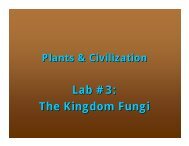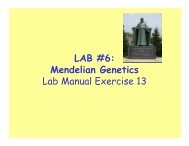Lab # 9: Autotrophic Protists - ALGAE
Lab # 9: Autotrophic Protists - ALGAE
Lab # 9: Autotrophic Protists - ALGAE
You also want an ePaper? Increase the reach of your titles
YUMPU automatically turns print PDFs into web optimized ePapers that Google loves.
<strong>Lab</strong> # 9: <strong>Autotrophic</strong><strong>Protists</strong> - <strong>ALGAE</strong>Plants & CivilizationSpring 2009
The <strong>Protists</strong>‣ Diverse group including both unicellular & multicellularspecies.‣ The evolutionary history (phylogeny) of these groupshas been difficult to determine by using cellstructure/function, nutrition, & reproduction alone.Recent molecular techniques have offered newevidence for showing the relationships of protists.‣ For our purposes, we will consider the groups westudy today “<strong>Protists</strong>” – a general term, not ataxonomic category.
The <strong>Protists</strong>‣ Diversity, Diversity, Diversity!• Unicellular (body is only comprised of one cell)• Filamentous (daughter cells attach in long line)• Colonial organisms (organizations of cells withno physiological connnection)• Multicellular (differentiated structures withincells to perform photosythesis, , flotation,anchorage, etc.)
The <strong>Protists</strong>‣ Consider 3 main categories based on modeof nutrition:1. Protozoa – heterotrophic protists that ingestfood by phagocytosis.2. Algae – photosynthetic unicellular/multi-cellularorganisms.3. Slime molds – absorb nutrients from decomposingorganic matter.
<strong>Autotrophic</strong> <strong>Protists</strong>A. Division Dinoflagellata (dinoflagellates)B. Division Bacillariophyta (diatoms)C. Division Phaeophyta (brown algae)D. Division Rhodophyta (red algae)E. Division Chlorophyta (green algae)F. Slime molds
Division Dinoflagellata:The DINOFLAGELLATESExamples:Amphidinium, Gymnodinium, Glenodinium,PeridiniumHaeckel’s (artist)depiction ofdinoflagellateshttp://www.scottcamazine.com/personal/selforganization/haeckel/images/dinoflagellates_jpg.jpg
Division Dinoflagellata:The DINOFLAGELLATES• Single-celled• Photosynthetic• Some capable of bioluminescence• Cellulose wall in the form of an armor ofnumerous plates, each with flagellum.
Division Dinoflagellata:The DINOFLAGELLATES• Play important role in primary production inoceans.• Some can “bloom” or reproduce very rapidlygiving the water a red tint due to the redpigments in their bodies.• Cause “Red Tides”• One species of dinoflagellates, Pfiesteria,produces deadly neurotoxins• Kills invertebrates & fish• Linked to human illnesses & death
Red Tides & Dinoflagellates“Red waves at morning,surfers take warning”?http://shiftingbaselines.org/blog/archives/2005_07.html
Division Bacillariophyta:Examples:The DIATOMSNavicula, Synedra, CyclotellaHaeckel’sdepiction ofdiatomshttp://www.scottcamazine.com/personal/selforganization/haeckel/images/Diatoms_B_jpg.jpg
Division Bacillariophyta:The DIATOMS• Unicellular, or aggregate into chains or star-like groups• Photosynthetic• Protoplasts are enclosed by silica cell wallwhich remain even after cell dies.
Division Bacillariophyta:The DIATOMS• Variable shapes including bilaterallysymmetrical pennate (elongated, boat-shaped)& radially symmetrical centric forms.PennateCentrichttp://www.acadweb.wwu.edu/courses/envr429-rm/Robin/images/envr429/42_diatoms_100x.jpg
Division Bacillariophyta:The DIATOMS• Play important role in primary productivity incold marine waters.• Cell wall (silica) deposits are mined asdiatomaceous earth & have numerous economicuses.• Used in swimming pool filters, toothpaste, silverpolish (abrasives)• Can you think of any other uses?(Hint: recall the Victory Brewery Tour!!!)• Greatest value = produce excess carbohydrate& oxygen which is utilized by other organisms.
Division Phaeophyta:The BROWN <strong>ALGAE</strong>Examples:Kelps- Laminaria, Macrocystis, Nereocystis,Sargassum, , & Fucus (pron. “few-kiss”).http://oceanexplorer.noaa.gov/explorations/02sab/logs/aug09/media/weeds_600.jpghttp://www2.mcdaniel.edu/Biology/botf99/higheralgaef/lfalgae/fucus.jpghttp://www.flavorj.com/~skysea/DPSW/pages/980x700/Laminaria_saccharina_fs.jpg
“Kelp Forests”:BROWN <strong>ALGAE</strong>http://www.ianskipworth.com/photo/pcd1742/kelp_forest_15_4.jpg
Division Phaeophyta:BROWN <strong>ALGAE</strong>• Some of the largest algae are kelps, or brownalgae.• Appear brown (or dark olive green) because ofthe presence of a brown pigment calledfuxoxanthin, , in addition to chlorophyll a.
The Structure KELP:http://hypnea.botany.uwc.ac.za/marbot/images/lampallida2.gif
Division Phaeophyta:BROWN <strong>ALGAE</strong>• Commercially important• Algin extract, a polysaccharide in the cell wall ofbrown algae, is added to products.• Gives ice cream smoother texture• Added to toothpaste, pudding, ice cream & otherproducts as thickening or emulsifying agent.http://library.thinkquest.org/J002755/graphics/toothpaste.gifhttp://adweek.blogs.com/photos/uncategorized/haagendaz1.jpg
Division Rhodophyta:Examples:The RED <strong>ALGAE</strong>Corallina, Polysiphonia, Porphyridiumhttp://www.ucmp.berkeley.edu/protista/reds/porphyra.gifhttp://bio.classes.ucsc.edu/bio161/KFE%20algae%20photos/Corallina_1.jpghttp://www.unizh.ch/botinst/Roscoff2002/Algen/Polysiphonia.jpg
Division Rhodophyta:The RED <strong>ALGAE</strong>• Some are single-celled; others are macroscopic& multicellular.• Do not have a flagellum at any stage during theirlife cycle.• Contain chlorophyll a, , but appear red due toaccessory pigments, phycocyanin &phycoerytherin.• These pigments absorb green & blue wavelengthsof light that penetrate the deep ocean waters.
Division Rhodophyta:The RED <strong>ALGAE</strong>• Agar, , a polysaccharide extracted from the cellwall of red algae, is used to grow up bacteria onpetri dishes.• Carrageenan, , another extract, is used to givethickness & richness to dairy drinks, soups, &ice-cream cream (check the label!).http://biology.clc.uc.edu/fankhauser/<strong>Lab</strong>s/Microbiology/Bacterial_Inhibition/Pour_seeded_agar_P7231208md.jpghttp://www.oneillseaodyssey.org/images/learning/equipment/ecology/carrageenan.jpg
Division Rhodophyta:The RED <strong>ALGAE</strong>The dried blade of Porphyra perforata, , a membranous red alga fromthe rocky intertidal zone of southern California. In Japan, speciesof Porphyra called "nori"nori" " are cultivated for food.http://www.lacoctelera.com/dulcejulian/imagen/Sushi.jpghttp:/ waynesword.palomar.edu/ algae1.htm
Division Chlorophyta:The GREEN <strong>ALGAE</strong>Examples:http://www.cryptogamicbotany.com/images/oa_chloro/Ulva_lactuca_01_06_18_A_600x550.jpgSpirogyra, Ulva, Acetabularia, Chlamydomonas,Pandorina, Volvox, Nitella.http://www.btinternet.com/~stephen.durr/volvoxc.jpghttp://coexploration.org/bbsr/coral/assets/images/acetabularia.jpghttp://protist.i.hosei.ac.jp/PDB/Images/Chlorophyta/Chlamydomonas/Euchlamydomonas/multitaeniata/sp_21.jpg
Division Chlorophyta:GREEN <strong>ALGAE</strong>• Diverse group including unicellular motile &nonmotile, , colonial, filamentous, andmulticellular species.• Primarily live in freshwater.• Appear light green in color due to presence ofchlorophylls a & b.
Green Algae & Land Plants:• Share many characteristics:• Both groups store starch• Have chlorophylls a & b• Photosynthetic pathways similar• Organic compounds (flavonoids(flavonoids)• Botanists have support for hypothesisthat land plants evolved from greenalgae.• Some want to include ‘green algae’ in the KindgomPlantae (rather than Protista).
Green Algae & Land Plants:• Chara, , a stonewort, is a multicellular,branched green alga thought to be mostsimilar to the green algae that gave rise toland plants….over 400 m.y.a.!!!.!!!http://bib18.ulb.ac.be/Botanique_I/image/880158992005_chara.jpg
Fungus-like<strong>Protists</strong>SLIME MOLDS (Myxomycota):Examples:“scrambled egg” & “dogvomit” slime moldswaynesword.palomar.edu/ slime1.htm
Fungus-like<strong>Protists</strong>SLIME MOLDS (Myxomycota):What are they????What are they????What are they????Once called a plant, a fungus,an animal, a fungus animal,protozoan, Protoctista, Protistaand inspired the famousmovie, “The Blob” whichdeemed it an “amoeba-like lifeform”, Slime Molds are nowclassified as <strong>Protists</strong> (at leastfor now!).http://botit.botany.wisc.edu/toms_fungi/images/blob1.jpg
Characterization ofSLIME MOLDS:• Phagocytic like protozoa (fungi are notphagocytic, , they absorb theirnutrients).• Cellular ultrastructure, , cell wallchemistry & molecular studies indicatethat slime molds fit better withamoeboid protists than with fungi.
Plasmodial SLIME MOLDS:Plasmodialhttp://faculty.clintoncc.suny.edu/faculty/Michael.Gregory/files/Bio%20102/Bio%20102%20lectures/<strong>Protists</strong>/Physarum.JPGPhysarum• Multinucleate massof protoplasm withno cell wall.• Feeds on bacteria asit grows on logs ordead leaves.• When conditions areright, it will producefruiting bodies, orspores.
Today’s s Plan:‣ Observe 6 Protista Stations in <strong>Lab</strong>:1. Dinoflagellates2. Diatoms3. Brown Algae4. Red Algae5. Green Algae6. Slime Molds‣ Work through lab manual, noting commonfeatures as well as the great diversity seen.‣ Answer questions, fill in tables, & makesketches where noted.Wait…there’s more!
Today’s s Plan (continued):‣ Take FINAL ‘Mineral Nutrition’ measurements,including the final mass of seedlings 1, 2, & 3.‣ Turn in these data so they can be combined.‣ You will be given the combined data in a fewdays…youryour “Big <strong>Lab</strong>” report is due on Tuesday, April17 – in lecture 10:00 am sharp - upon return fromEaster Break. Late papers will be penalized 5points/day. If you miss lecture to write your paperyou will lose 5 points! Late is late!




